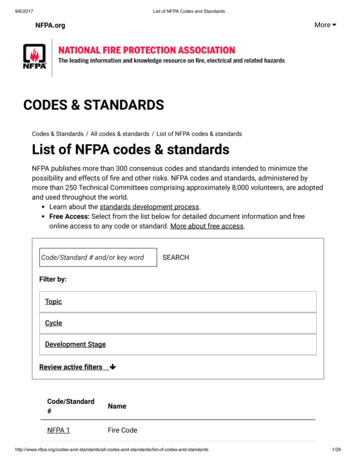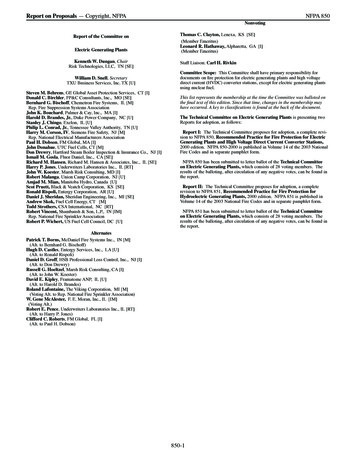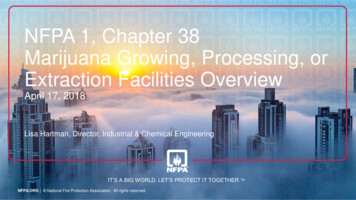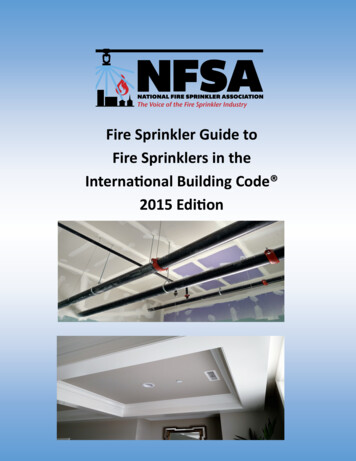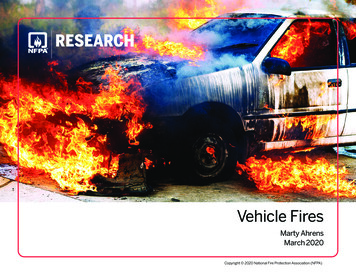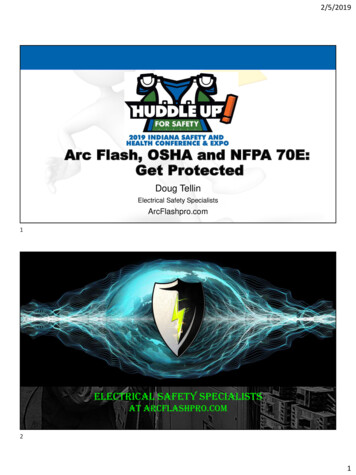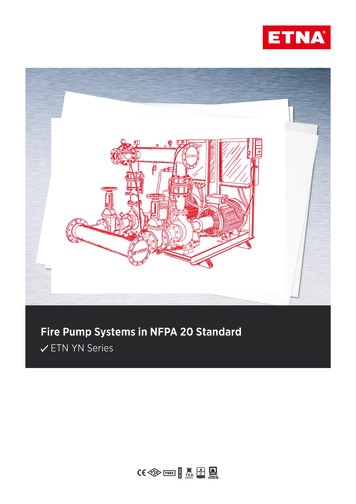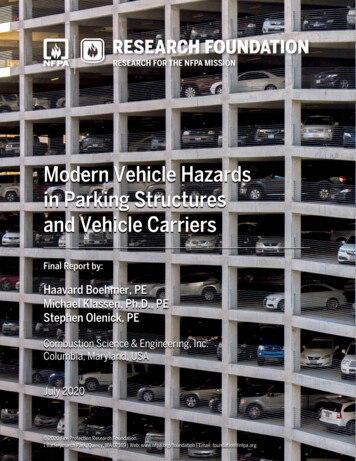
Transcription
Modern Vehicle Hazardsin Parking Structuresand Vehicle CarriersFinal Report by:Haavard Boehmer, PEMichael Klassen, Ph.D., PEStephen Olenick, PECombustion Science & Engineering, Inc.Columbia, Maryland, USAJuly 2020 2020 Fire Protection Research Foundation1 Batterymarch Park, Quincy, MA 02169 Web: www.nfpa.org/foundation Email: foundation@nfpa.org
—— Page ii ——
ForewordVehicles have changed significantly over the years. Modern vehicles present new hazards, such as due to theincorporation of larger quantities of combustible materials (e.g. fuels, plastics, synthetic materials, etc.) intotheir designs. As alternative fuel vehicles are popularized, concerns regarding their unique hazards, burncharacteristics, and typical burn duration have been raised. Compared to older vehicles, modern vehiclesburn differently. Modern parking garages have optimized space requirements for vehicle parking and storageand often implement automated retrieval features and car stacking, which presents unique hazards as well.Thus, it raises the question if the safety infrastructure of these parking structures and vehicle carriers (i.e.maritime vessels) have kept pace. This project aimed to quantify the fire hazard of modern vehicles in parkingstructures and vehicle carriers to provide guidance for the applicable technical committees.The Fire Protection Research Foundation expresses gratitude to the report authors Haavard Boehmer, PE,Michael Klassen, Ph.D., PE, and Steven Olenick, PE, who are with Combustion Science & Engineering, Inc.located in Columbia, MD, USA. The Research Foundation appreciates the guidance provided by the ProjectTechnical Panelists, the funding provided by the project sponsors, and all others that contributed to thisresearch effort. Thanks are also expressed to the National Fire Protection Association (NFPA) for providingthe project funding through the NFPA Annual Research Fund.The content, opinions and conclusions contained in this report are solely those of the authors and do notnecessarily represent the views of the Fire Protection Research Foundation, NFPA, Technical Panel orSponsors. The Foundation makes no guaranty or warranty as to the accuracy or completeness of anyinformation published herein.About the Fire Protection Research FoundationThe Fire Protection Research Foundation plans, manages,and communicates research on a broad range of firesafety issues in collaboration with scientists andlaboratories around the world. The Foundation is an affiliate of NFPA.About the National Fire Protection Association (NFPA)Founded in 1896, NFPA is a global, nonprofit organization devoted to eliminating death,injury, property and economic loss due to fire, electrical and related hazards. Theassociation delivers information and knowledge through more than 300 consensuscodes and standards, research, training, education, outreach and advocacy; and bypartnering with others who share an interest in furthering the NFPA mission.All NFPA codes and standards can be viewed online for free.NFPA's membership totals more than 65,000 individuals around the world.Keywords: parking structures, parking garages, vehicles, vehicle carriers, ICE vehicles, electric vehicles,sprinkler criteria, NFPA 13, NFPA 88A, NFPA 301, vehicle hazards.—— Page iii ——
Report number: FPRF-2020-07Project Manager: Victoria Hutchison—— Page iv ——
Project Technical PanelKyle Bowker, NHTSAKevin Carr, NFPA, NFPA 88A Staff LiaisonMichael Carsillo, International Fire Marshals Association (IFMA), NFPA 88A ChairmanMark Cummings, Fire Risk Management, NFPA 301 ChairmanBenjamin Ditch, FM Global (alternate to Rich Wardak)Chad Duffy, NFPA, NFPA 13 Staff LiaisonTom Gardner, Harrington GroupKevin Hall, NFSAMark Hopkins, Terp ConsultingJason Huczek, Southwest Research Institute (SwRI)Stuart Lloyd, ZurichTom Pedersen, IKEALawrence Russell, NFPA, NFPA 301 Staff LiaisonRich Wardak, FM GlobalSteve Wolin, Reliable Automatic SprinklerSponsor RepresentativesCasey Grant, SFPE FoundationProject SponsorsNational Fire Protection Association (NFPA)SFPE Foundation—— Page v ——
Modern Vehicle Fire Hazardsin Parking Garages andVehicle CarriersFinal Report by:Haavard Boehmer, P.E.Michael Klassen, Ph.D., P.E.Stephen Olenick, P.E.Combustion Science & Engineering, Inc.Columbia, Maryland, USAJuly 2020 2020 Fire Protection Research FoundationOne Batterymarch Park, Quincy, MA 02169, USA Email: foundation@nfpa.org Web: nfpa.org/foundation
Modern Vehicle Hazards in Parking Garages and Vehicle CarriersExecutive SummaryFires in vehicles are not uncommon, but the majority of these occur along the road or aftercollision. Vehicle fires in parking structures developing into large, out of control events are fairlyrare, and civilian injuries in these types of incidents number fewer than two dozen annually in theUSA. However, fires in parking structures can lead to very large economic losses, as evidencedby recent fires at Liverpool’s Echo Arena (UK) and at the Stavanger Airport (Norway). Theseincidents involved hundreds of automobiles and resulted in severe structural damage. Fires onmarine vehicle carriers or ferries are extremely challenging due to the setting and can result ininjury and loss of life to passengers and crew, as well as loss of the cargo and the vessel. Dataon modern vehicles imply there is a small, and shrinking, margin of error when a single vehiclefire can develop into a conflagration. It is important to understand the hazard posed by modernvehicle fires and determine if current fire codes are mandating adequate fire protectionrequirements.This report details an analysis of the current scientific literature regarding the fire hazard modernvehicles represent to parking garages and marine vessels. The changes in vehicle and garagedesign have been documented, and the factors that most impact the fire development have beenidentified. Areas where current codes may be inadequate are presented and knowledge gaps andpotential areas of research required to address the hazard are identified.There has been an increase in the fire hazard from changes in vehicle design and increased useof plastics and other combustible materials in vehicle construction. The increased plastic contentof modern vehicles manifests as faster flame spread within the vehicle, easier ignition and morerapid fire spread to neighboring vehicles. Modern parking garages tend to have narrower parkingspaces than before, with increasing use of vertical stacker systems, leading to more denselypacked fuel loads. The spread of fire between cars in a garage, especially from the initial to thesecond and third vehicles, is shown to be critical in determining the extent of the fire and the abilityof the fire department to successfully control and extinguish it. There is limited test data availableon this spread between multiple vehicles, especially on newer cars. Some testing of multiplemodern vehicles has shown very rapid fire spread between vehicles in a parking garageconfiguration, on the order of 10-20 minutes. Based on the findings, test data from older vehicles( 15-20 years at the time of writing) should not be used as basis for development of codes andregulations.The evaluation of modern vehicle fire hazards and current code requirements found that forenclosed parking garages and marine vessels the existing requirement for active protectionsystems appears adequate to control a vehicle fire until the fire department arrives, based onhistorical fires and laboratory testing. Open parking structures emerge as the main area ofconcern regarding fires in modern vehicles. The lack of any requirements for active protectionsystems in fire codes, and trends in both vehicle and garage design suggest that large,devastating fires in these structures could become increasingly common. Though the risk ofcivilian injuries will continue to remain low, these fires could cause extremely large propertylosses, business disruption, and adverse environmental impact. The current knowledge gapsfocus on three areas; earlier detection and notification, viable sprinkler protection, and fire spreadbetween vehicles. Focus of potential research in these three areas is proposed to better evaluateand analyze the threat of modern vehicle fires in open parking garages. This understanding isalso critical to determine the best approach to reduce the risk of catastrophic fires.Page 1
Modern Vehicle Hazards in Parking Garages and Vehicle CarriersTable of ContentsList of Figures . 4List of Tables . 51.Introduction . 62.Identification of the Problem . 6Notable Vehicle Fire Incidents . 7Storage and Transportation of Vehicles . 93.Current Protection Requirements . 9NFPA 88A - Vehicle Parking Structures .103.1.1.Open and Enclosed Parking Garages .103.1.2.Detection, Notification and Automatic Sprinkler Systems .103.1.3.Fire Resistance and Compartmentation .11International Parking Garage Codes .11Marine Vehicle Carriers Codes .124.3.3.1.NFPA 301 and 46 CFR .133.3.2.IMO Standards.14Modern Vehicle Fire Hazards .14Vehicle Sizes and Use of Plastics .15Plastic Fuel Tanks.17Future Developments.17Alternative Fuel Vehicles.17Modern Parking Structures .194.5.1.5.Building Design .19Modern Vehicle Hazard Assessment .20Vehicle Design .205.1.1.Heat Release Rate .205.1.2.Vehicle Fire Tests .215.1.3.Plastic Fire Energy .245.1.4.Fire Spread .255.1.5.BRE (UK) Vehicle Fire Tests.255.1.6.Fire Resistance Rating Time-Temperature Requirements .265.1.7.Plastic Fuel Tanks .28Battery Electric Vehicles .295.2.1.Battery Energy Release .295.2.2.Extinguishment .31Marine Vehicle Transport Vessels.32Page 2
Modern Vehicle Hazards in Parking Garages and Vehicle CarriersFire Spread .335.4.1.Spill Fire as Method of Fire Spread .34Thermal Effects of Modern Vehicle Fires .355.5.1.Spalling of Concrete.355.5.2.Failure of Structural Steel.36Design of Parking Garages .375.6.1.Vehicle Stackers .37Modern Vehicle Fire Hazard Summary of Findings .396.Existing Design Criteria and Modern Vehicle Fires.40Marine Vehicle Carrier Vessels .40Enclosed Parking Garages .40Open Parking Garages .417.Addressing Hazards from Modern Vehicles .42Detection and Notification .42Automatic Sprinkler Systems .428.Knowledge Gaps.43Effect of Earlier Fire Detection and Notification .43Effectiveness of Automated Sprinkler Systems .44Fire Spread .458.3.1.Fuel spill .458.3.2.Concrete Spalling .45Open Garage Definition .459.10.Conclusions .46References .47Page 3
Modern Vehicle Hazards in Parking Garages and Vehicle CarriersList of FiguresFigure 1 – Partially collapsed parking garage at Norway’s Stavanger Airport after fire in January,2020. 8Figure 2 – Amount of plastic in average US light vehicles in weight (kg), and as percentage ofvehicle curb weight. .16Figure 3 – Test demonstrating the difference between hydrogen and gasoline fires. .18Figure 4 – Example of car stacker system.19Figure 5 – Select heat release rate curves for vehicles from each decade. .23Figure 6 – Curb weight and plastic content potential fire energy from average north Americanvehicles from 1975 to 2018. .24Figure 7 –Configuration of openings in BRE test [BRE, 2010]. .26Figure 8 – ASTM E119 time-temperature curve [ASTM, 2014].27Figure 9 – Temperature above the car during full scale testing [Shipp and Spearpoint, 1995].28Figure 10 – Failing plastic fuel tank [Digges, 2003]. .29Figure 11 – Heat release rate for two pairs of similar ICE and EV vehicles for tests conducted byLecocq, [2012]. .30Figure 12 – Comparison of heat release rate from internal combustion and electric vehicles inLam et.al. [2012] .31Figure 13 – Flame jet from Tesla model X battery electric car [NBC LA, 2017]. .32Figure 14 – Concrete spalling in Liverpool, England 2017 fire. .35Figure 15 – Concrete spalling in Stavanger, Norway 2020 fire. .36Figure 16 – Vehicle and sprinkler arrangement for the BRE stacker test [BRE, 2009]. .37Figure 17 – Non-sprinklered test at 10 min [BRE, 2010].38Figure 18 - Sprinklered test at 1 hour, 23 min [BRE, 2009].38Page 4
Modern Vehicle Hazards in Parking Garages and Vehicle CarriersList of TablesTable 1 – Parking garage fires in 2019. Included is the model of the vehicle identified as the initialsource of the fire. . 8Table 2 – Sprinkler coverage and spacing requirements for ordinary and extra hazard (hydrauliccalculated 10.2 mm/min (0.25 gpm/ft2) from NFPA 13 (2019).11Table 3 – Fire protection strategies from five vessel operators responding anonymously to theresearch panel. .12Table 4 – Increase in body width and curb weight of the two most popular vehicles in the USAfrom 1970s to 2018. .15Table 5 – Most common plastic types used in US vehicles. .17Table 6 – ANSI classifications of vehicle [Tohir and Spearpoint [2013]. .21Table 7 – Select vehicle fire test results from several sources. .22Table 8 – Ignition source and test conditions for the five tests in Figure 5 .23Page 5
1. IntroductionThe effect on fire dynamics in residential fires due to modern construction techniques, floor plans,and use of polymer materials is well studied. Less effort has focused on the impact on fire hazardsfrom changes in vehicle design and changes in production techniques, material types and materialusage in vehicle construction. Additionally, the adoption of different motor technologies and theuse of alternative fuels such as battery electric vehicles and hydrogen fuel cells present differentvehicle configurations and burn characteristics. Large lithium-ion batteries and hydrogen fuel cellsin vehicles may represent a change in the type of hazard and required fire protection andfirefighting techniques in parking structures. These developments will have significant implicationstouching on many different areas, such as design of parking garages and vehicle carriers,suppression systems, as well as firefighter tactics. While still low in percentage of total sales, thenumber of electric vehicles (EVs) on the road around the world has increased in the last few yearsrepresenting 2-4% of all sales. The rate of sales growth is also rising dramatically, nearly doublingfrom 2017 to 2018 [IEA, 2019]. Hydrogen fuel cell vehicles are currently less developed andmainly still in the research stage, with a few thousand sold and refueling stations limited to a fewtest areas [Antoni et.al., 2018].The goals of this project are to review current literature on vehicle fire hazards and protectionrequirements, thoroughly identify and evaluate the hazards associated with modern vehicle fires,including how, and to what degree, they may differ from older vehicles. Current design guidelines,codes and criteria for vehicle storage facilities and carriers will be evaluated, and how thesestructures and vehicles may be impacted by fires. Finally, guidelines and areas for furtherresearch will be discussed.2. Identification of the ProblemThere is a concern that the materials used in modern vehicles present a significant increase inenergy content during a fire, both in intensity and duration, compared to older vehicles. Thesechanges in materials may have an impact on the fire hazard posed by vehicles. Especiallyconcerning is that many design guidelines and standards were developed using supposedlyconservative values based on vehicle fire tests performed many decades ago and assume therewill be limited fire spread between vehicles before suppression. The assumptions, forming thebasis for the fire resistance and suppression system requirements, may in fact underestimate thehazards from a vehicle fire. If fires in modern vehicles do present a greater hazard due to thechanging materials, the increased fire intensity will have an external impact on design of parkingfacilities, vehicle carriers, ferries, and any other facilities where a large number of vehicles aredensely placed. The potential change in fire hazard associated with modern vehicles has beenhypothesized due to two well-documented developments:1. Larger vehicles with increased use of polymers and other combustible materials inconstruction, which are parked closer together. These materials often ignite easier,contain more chemical energy per volume, and burn more intensely and/or longer thanlegacy materials.2. Rapid growth of alternative fuel vehicles replacing internal combustion engines (ICE).These include plug-in hybrid electric vehicles (PHEVs), fully electric vehicles (EVs), andhydrogen fuel cell vehicles.Statistics on vehicle fires are published by National Fire Data Center and the US FireAdministration [2018]. These statistics do not distinguish which fires occurred in parking garages,or any other information about the location of the vehicle when the fire occurred. In total from 2014to 2016 there were an average of 171,500 vehicle fires each year in the USA. Analyzing data forPage 6
2002-2005, Ahrens [2008] states that in the USA only 1% of vehicle fires, or 4,300 annually (with2 fatalities annually), occurred in “storage” locations, which include those in parking garages. It isalso reported that vehicle fires are involved in 18% of all US fires, and cause 13% of deaths and10% of the direct property damage. Vehicle fires thus result in relatively fewer injuries and damagein relation to their share of total number of fires. This is likely because many of the fires classifiedas vehicle fires occur in a vehicle along the road, possibly related to a collision, with no spreadand only resulting in the loss of a single vehicle. Evaluating data for fires occurring in commercialparking garages in the USA for the period 2014-2018 Ahrens [2020] found that on average therewere annually 1,858 fires, causing 22.8 million in direct property damage and 20 civilian injuries.Notable Vehicle Fire IncidentsAlthough fires involving automobiles are not uncommon, there have been a number of incidentsin the last decade that are noteworthy for the scope and severity of the event. As would beexpected, significant incidents generally involve a high density of automobiles within a structureor vehicle carrier, where the close proximity of the vehicles leads to rapid fire spread.One of the larger recent events occurred in Liverpool, England in December of 2017 in an open,8-level concrete parking garage with 1,600 car capacity. A fire believed to have started in a 2002model Land Rover that had been “converted to a different fuel arrangement” (the nature of theconversion is not specified), and spread throughout the parking structure, resulting in damage toover 1,400 vehicles, and structural damage so severe the building will be demolished [BBC, 2018;Kirkham, 2018]. The local fire chief claims that had the parking garage been equipped withsprinklers it would have made it easier to contain and put out the fire, by putting more water onthe fire [Bona, 2018]. The fire chief also points out that when dealing with a “running fuel fire”foam is required, which the local fire department did not have access to. Once the fire fullydeveloped, fire crews reported additional vehicles becoming involved every 30 seconds.Another fire with very extensive impact occurred on January 8th, 2020 in an open parking garageat Stavanger airport in Sola, Norway [The Local, 2020]. The fire is reported to have started in a2006 diesel car (Opel Zafira) [Frafjord, 2020]. A similar model car is also reported to have starteda fire in an Irish parking garage, and has been subject to a recall [English, 2019]. The incidentvehicle at Sola was a 2nd generation with left side steering, while the UK recall applied to 1stgeneration vehicles with right side steering [Karlsen, 2020]. The Norway fire destroyed 200-300vehicles inside the building, with a further 1,300 vehicles trapped with some degree of heat andsmoke damage, and part of the five-story structure collapsed (see Figure 1). The owner of theoriginating vehicle stated that he attempted to start it, saw smoke coming from the enginecompartment, and soon after flames. News articles about the incident report that it still took thefire department approximately 19 minutes from ignition until first units arrived [Klingenberg andRamsdal, 2020], and that the first fire fighters claimed to have seen as many as 10 vehiclesburning on arrival, though this has not been confirmed. As the airport firefighters are not able torespond to non-aircraft fires while the airport is operating, the closest responding fire fighters hada travel time of up to 13 minutes (at normal driving speed).Page 7
Figure 1 – Partially collapsed parking garage at Norway’s Stavanger Airport after fire inJanuary, 2020.While automobile fires themselves are considered among the largest causes of fatalities in theUS [Diggs, 2008], most of the large, notable parking garage fires in recent years have led to largematerial losses but have not involved any human fatalities and few injuries [Ahrens, 2020]. A 2004collapse of an underground parking garage in Gretzenbach, Switzerland after a fire trappedseveral firefighters, with seven eventually dying as a result [Firehouse, 2004]. The parking facilitywas underneath a playground and the fire started in a parked vehicle. After approximately90 minutes, the concrete roof collapsed. It should be noted that the fire was described as“relatively small”, and concerns have been raised about excessive load from the soil on the roof[Annerel, et.al. 2013]. Some other notable parking structure fires are summarized in Table 1.There were no fatalities in any of these fires.Table 1 – Parking garage fires in 2019. Included is the model of the vehicle identified asthe initial source of the fire.Initiating Vehicle(Model)Newark, NJ# ofVehicles1 (2 othersdamaged)17 (2 totaled)9/16/19Miami, FL1Hyundai Elantra4/10/194/22/196/29/195/26/19Myrtle Beach, SCShanghai, ChinaChicago, IllinoisHouston, Texas1332Tesla Model S (EV)-2/7/20Gaithersburg, MD4“SUV”DateLocation9/23/19Richmond, VA1/31/19Audi sedanDodge DurangoParking StructureTypeParking garage(multi-use)Parking garage roofResidential parkinggarageParking garageParking garage10 story garageIn a parking garageGarage. Spread toneighbor vehiclesLikewise, fires on marine vehicle carriers or ferries can result in injury and/or loss of life topassengers and crew, as well as the property loss of the cargo and the vessel itself. Since 2014Page 8
there have also been six significant fires on marine vessels. Examples include fires on the M/SNorman Atlantic (2014 Adriatic Sea); M/V Courage (2015, English Channel); M/V Silver Sky(2016, Antwerp, BE); M/V Honor (2017, English Channel) and M/V Sincerity Ace (2019 PacificOcean). A fire occurred on June 4th, 2020 onboard the M/V Höegh Xiamen [Schuler, 2020]. Thefire started on the Number 7 deck of the vessel loaded with automobiles. These may have beenused vehicles with various unknown amount of fuel in the fuel tanks. The fire spread throughoutthe vessel and burned for more than a week and required the response of 120 firefighters. OnJune 5th during the extinguishment effort, an explosion occurred which injured eight firefighters.The vessel was declared a total loss, and the investigation into the cause is ongoing (at the timeof this report)
laboratories around the world. The Foundation is an affiliate of NFPA. About the National Fire Protection Association (NFPA) . parking structures, parking garages, vehicles, vehicle carriers, ICE vehicles, electric vehicles, sprinkler criteria, NFPA 13, NFPA 88A, NFPA 301, vehicle hazards. —— Page iv —— . Fire Resistance and .

